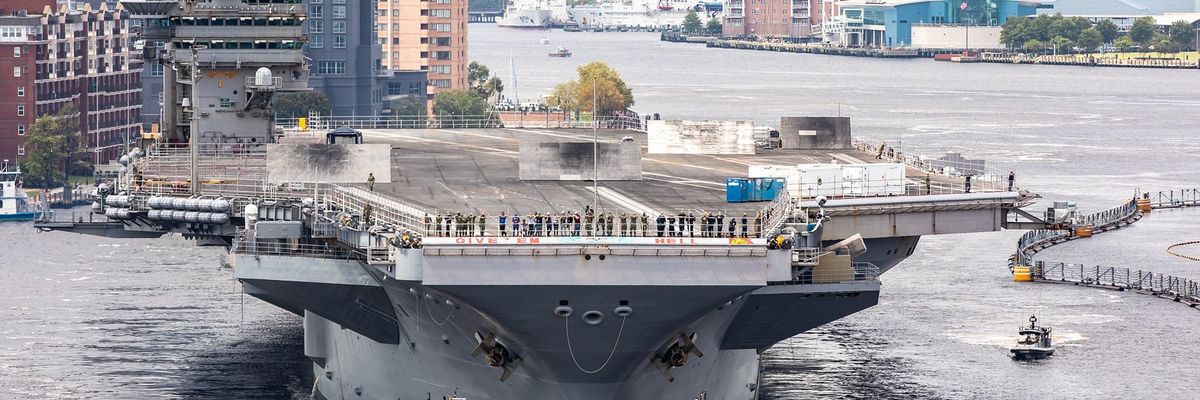Congress is approaching a crossroads on its naval fleet development. It should choose restraint.
Budget watchdogs and members of Congress are eagerly awaiting full details of President Biden’s defense budget request, and one of the most important questions the new administration must face — which could have spending impacts for decades to come — is the present and future size of our naval fleet.
Indeed, 2021 may represent a crossroads for the Department of Defense and Congress when it comes to naval fleet development for the next 30 years, and lawmakers would be wise to opt for restraint. The alternative seems to be doubling down on the grand and irresponsible plans of the past few years.
A quick summary: the total fleet of the U.S. Navy currently stands at 301 ships. A December 2016 report from the Navy, in the outgoing months of the Obama administration, called for increasing the size of the fleet to 355 by 2034 — an 18 percent increase over 15 years. The outgoing Trump administration upped the ante in December 2020 by calling for anywhere from “382 to 446 manned ships and 143 to 242 large [unmanned vehicles or] UVs” — an increase of between 75 percent and 130 percent over 30 years.
The nonpartisan Congressional Budget Office estimated that new ship construction alone under the Trump plan would cost $865 billion over 30 years, or an average of $28.8 billion per year. For context, this is more than two times the historical average of annual shipbuilding costs over the past 30 years. On the contrary, CBO estimated in December of last year that reducing naval ship construction funding to that of historical levels over the past 30 years would save taxpayers $50.8 billion over the next 10 years alone.
At a time of mind-boggling $28-trillion debt and soaring deficits, the fiscally responsible option here seems obvious. But even if one were to suspend budget realities for a moment — and let’s do just that, and assume the U.S. is running a surplus and has billions of dollars to spend — spending literal boatloads of money on dozens of new ships may be irresponsible from a military planning perspective as well.
Both CBO and the similarly nonpartisan Government Accountability Office have reported in recent months on the sorry state of the public naval shipyards where ships currently in the fleet are repaired and maintained. GAO found in an August 2020 report that the four shipyards were late on scheduled maintenance of aircraft carriers and submarines three-quarters of time between 2015 and 2019. The shipyards didn’t just miss their maintenance schedules by a day or a week, either — the average delay for aircraft carrier maintenance was 113 days (or nearly four months), and the average delay for submarine maintenance was 225 days (or around five and a half months).
CBO reported more recently on shipyard issues, and their paper features many of the same findings as GAO. Their topline finding was that these maintenance delays are projected to continue long into the future — 25 of the next 30 years, to be precise. Even more confounding, CBO projected those significant delays while accounting for the Navy’s projected “efficiency gains” (which may not come to pass) and a $21 billion pot of money projected to come into the Navy’s coffers over the next 20 years for shipyard infrastructure improvements.
More importantly, CBO offered four options for fixing these delay issues over the next 30 years: 1) the Navy could improve its forecasting of shipyard maintenance needs to reduce the likelihood of delays, 2) Congress could authorize the Navy to add more workers to its shipyards, 3) the Navy could start sending ships to private shipyards to fill in the gaps, or 4) the Navy could reduce the size of its fleet.
Some lawmakers think they’ve found a fifth option, and it’s a classic congressional fix: throw more money at the problem, and faster.
A bipartisan group of senators and representatives have introduced the SHIPYARD Act of 2021, which would take that $21 billion pot of projected money for the Navy — meant to be spread out over the next 20 years — and give it all to them immediately. The bill text seems to contain no safeguards against the Navy spending the money too quickly or in an irresponsible manner, and in fact grants the Navy some Defense Production Act authorities that will allow it to sign contracts (read: spend money) even more quickly than under typical procurement practices. The supporting lawmakers are apparently already angling to get this pot of money included in President Biden’s infrastructure bill, and they apparently have the support of powerful Democrats Rep. Adam Smith (D-Wash.), chair of the House Armed Services Committee, and Rep. Joe Courtney (D-Conn.), chair of the House Armed Services Seapower Subcommittee.
Indeed, it’s a significant uphill battle to get Congress to want to spend less on something — especially in the defense budget — but CBO indicates that in this case less may be more. As they put it:
Option 4 would reduce the size of the fleet by approximately five attack submarines to match the public shipyards’ maintenance capacity. That could be accomplished by retiring older submarines ahead of the current schedule or by purchasing fewer new submarines. Although the size of the fleet would be smaller, the same number of submarines might be available in peacetime as under the Navy’s plan because fewer submarines would be awaiting maintenance.
Defense hawks may quickly try to claim that we need a larger naval fleet to compete with China, but a recent report from John Isaacs at the Center for Arms Control and Non-Proliferation is enough to generate significant skepticism about the hawks’ claims:
When the Pentagon’s 2020 “China Military Power Report” claims that the Chinese Navy is the largest in the world, with 350 ships and submarines, compared to the U.S. Navy battle force of 293 ships, it should add that the U.S. Navy has at least a 2-1 advantage in tonnage over China and a 10-1 lead in carrier-based aircraft.
In other words, China may have more total ships and submarines, but the U.S. has larger ones — and way more aircraft carriers, too. The advantages are not insignificant, either.
To put it another way, the U.S. Navy can make do with less now — and can solve its maintenance issues with less money, not more. Congress should consider that approach for a change. Taxpayers worn weary by $5 trillion in deficit-financed pandemic spending and a $750 billion annual defense budget are depending on lawmakers to choose less, not more, at this critical crossroads.
















